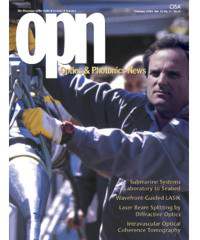
February 2004 Issue
Feature Articles
Intravascular Optical Coherence Tomography Opens a Window Onto Coronary Artery Disease
In the United States alone, more than 650,000 people die each year of heart attacks related to coronary artery disease. A new technique, intravascular optical coherence tomography, may play an important role in guiding therapeutic interventions, diagnosing atherosclerosis and researching the causes of coronary artery disease.
by Joseph Schmitt, David Kolstad and Christopher PetersenWavefront-Guided LASIK
Laser surgery to correct refractive error in the eye has become one of the most widely performed surgical procedures. Studies show most patients who undergo wavefront-guided LASIK, in which individual aberration patterns are measured pre-operatively so a customized ablation pattern can be generated for each eye, are achieving improved visual acuity under all light conditions.
by Jim SchwiegerlingSubmarine Systems: From Laboratory to Seabed
Technological advances in recent decades have enabled submarine cable systems to become the backbone of today’s intercontinental telecommunications networks.
by Vincent LetellierLaser Beam Splitting by Diffractive Optics
Recent advances in diffractive optics theory and technology have made it possible to design programmable, multichannel optical systems based on diffraction gratings, lenslet arrays and digital holography algorithms. Spot array generation, multiple and multifocal imaging, matched filtering, laser beam mode selection and simultaneous contour shaping are among the most promising applications of diffractive beam splitting.
by Michael A. GolubDepartments and Columns
A Scientist Who Studied Vision and Saw a World in Crisis
This article is part of an occasional series highlighting eminent optical scientists in history. George Wald was one of 23 OSA members to have been honored with the Nobel Prize. OPN writer Susannah Lehman interviewed members ofWald’s family and others touched by his life and work.


![A multiplexed image of a human tonsil acquired. [NIAID] using the iterative bleaching extends multiplexity (IBEX) method.](https://opnmedia.blob.core.windows.net/$web/opn/media/images/articles/2024/0424/departments/202404-cover-web.jpg?ext=.jpg)
